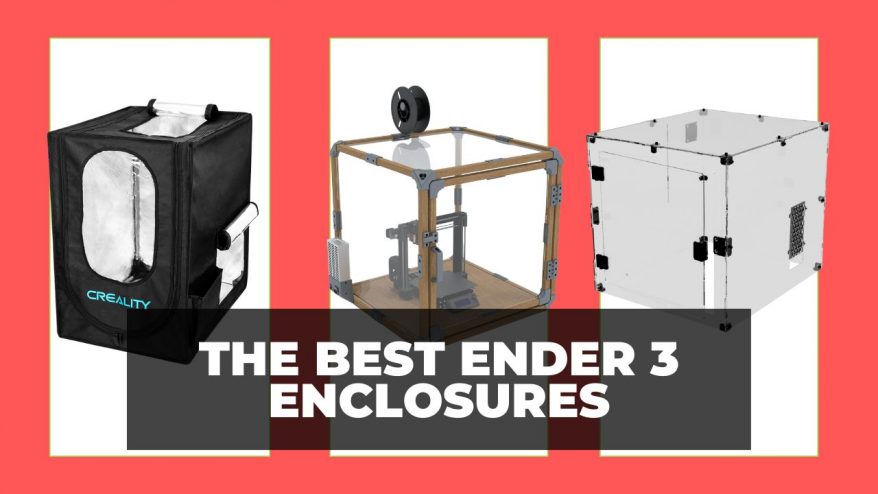
Nylon is extremely tough, resistant to heat, large shocks and impacts, and doesn’t scratch or wear down easily — no wonder it’s considered one of the best 3D printer filaments.
We’ve included our top Nylon filament 3D printing tips, as well as recommending the best Nylon filaments you can buy today.

- Nylon 3D Printer Filament Properties
- How to 3D Print with Nylon:
- Best Nylon 3D Printer Filament
- Best Nylon Filament Brands
- How much does Nylon filament cost?
- Reasons to 3D Print Nylon
- Disadvantages of Nylon filament
- Tips to get the best results from Nylon 3D printing
- Nylon Applications
- How to Store Nylon
- How to Dry Nylon
- Different Types of Nylon Filament
- Do You Need an Enclosed Chamber to 3D Print Nylon Filament?
- What Temperature Should I Print Nylon Filament At?
- Can Water in Nylon Filament Cause Extruder Clogs?
- Is Nylon Filament Toxic?
- What the difference between Nylon 6 filament and Nylon 12?
- Nylon 3D Printing FAQs
Nylon 3D Printer Filament Properties
Nylon is a form of polyamide, with forms such as PA12 commonly used in SLS 3D printers.
Nylon filament is known for being extremely tough and durable, as well as for its flexibility. Though ABS is known for its toughness, Nylon is a step above, with very high impact resistance, abrasion resistance and increased flexibility.
While filaments like PLA can be brittle, Nylon is tough, and when printed thick it can handle large shocks and impacts. Unlike ABS, it does not print with bad odors.
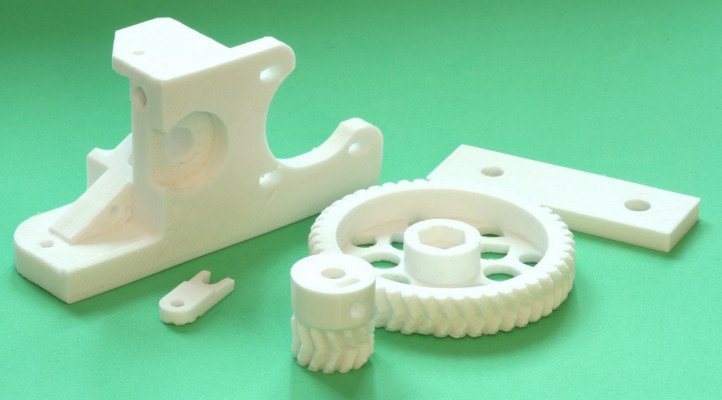
This makes it ideal for functional parts that can be made quickly using rapid prototyping, tested for errors, and quickly iterated on.
Nylon also offers very good surface finish if you use the right 3D slicer and printing settings, and despite the toughness can be printed very intricately and accurately. We discuss the best settings for 3D printing Nylon further on in our Nylon filament guide.
How to 3D Print with Nylon:
- Nylon filament temperature wants to be around 240°C-260°C and up (to around 290°C). We recommend incrementally experimenting with temperatures above this to find your ideal settings.
- Heated bed at around 80°C+. We recommend 100°C or more even, as Nylon is sensitive to cooling too fast, and that causes warping.
- To aid adhesion, use a PVA glue stick on a glass or metal print bed. Kapton tape can work also. Ultimately for best results, we suggest using a Tufnol sheet as a bed surface. This seems to work the best for Nylon, which is prone to warping if you don’t use the right surface.
- Make sure layer cooling fans are off and you’re not printing in a drafty or cool environment.
- Use an enclosure or heated chamber. As with ABS, Nylon parts may warp or curl if the part cools too quickly.
- Make sure you use dry Nylon filament. Nylon is extremely hygroscopic and wet nylon is weaker, rougher, and bubbly.
Best Nylon 3D Printer Filament
3DSourced is reader-supported. When you buy through links on our site, we may earn an affiliate commission. Learn more
There are a number of popular Nylon filament brands and types. The cheapest Nylon filaments can cost as low as $30 per kilo, whereas NylonX is more expensive as it is mixed with carbon fiber, as is NylonG which is mixed with glass fibers for added strength.
MatterHackers PRO Series Nylon
- Price: $62 – 0.75 kg spools – Available at Matterhackers here
- Printing Temperature: 240°C
- Bed Temperature: 60°C
- Filament Diameter: 1.75 mm and 2.85 mm
- Available Colors: Black, White, Blue, Gray, Orange, Red, Green

MatterHackers PRO Series Nylon is a premium material at a not so premium price. It’s made with some of the tightest tolerances among major manufacturers, with thorough quality assurance testing and a formula based on high-purity additives.
MatterHackers PRO Series Nylon is particularly well suited to applications that need a tough, impact-resistance filament with decent flexible properties.
MatterHackers also offers a broad range of colors, unlike many other manufacturers who stick to one or two plain colors, usually black and white.
MatterHackers NylonG
- Price: $64.00 – 0.5 kg spool – Available at Matterhackers here
- Printing Temperature: 255°C
- Bed Temperature: 65°C
- Filament Diameter: 1.75 mm and 2.85 mm
- Available Colors: Safety Orange, White, Blue, Desert Tan, Olive Green, Silver, Black, White, Red

MatterHackers NylonG glass-fiber-reinforced filament is a high-quality material designed to reduce Nylon’s natural flexibility, boosting impact resistance and tensile strength. It does this while still keeping its shape and structure intact even under heavy loads. Real-world applications include aerospace development and prototyping, automotive manufacturing, and others where structural integrity is critical.
Though a premium Nylon filament, MatterHackers NylonG remains reasonably priced for the quality on offer and is available in the company’s signature range of colorful options.
MatterHackers NylonX
- Price: $58.00 – 0.5 kg spool – Available at Matterhackers here
- Printing Temperature: 250-265°C
- Bed Temperature: 60-65°C
- Filament Diameter: 1.75 mm and 2.85 mm
- Available Colors: Matte Black
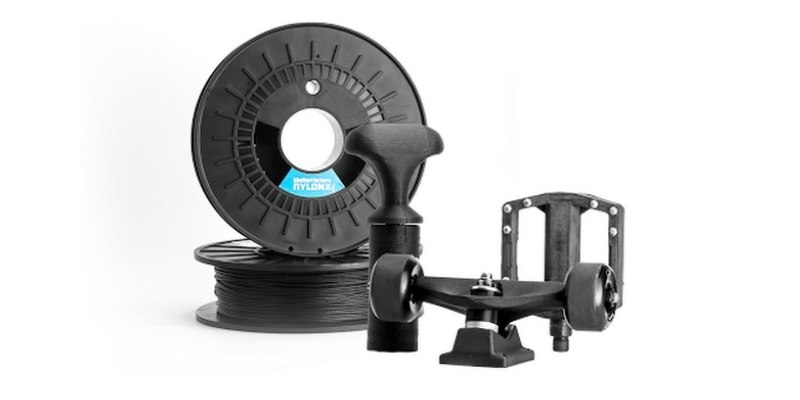
MatterHackers NylonX marries Nylon with micro-carbon fibers to create a tough, stiff, and durable engineering-grade material for functional, high wear-and-tear, shatter-resistant parts. It’s one of the most popular and best carbon fiber Nylon filament available.
Though MatterHackers NylonX is only available in matte black, the finish is smooth and requires no post-processing. It’s a high-performance filament with a price tag to match and is easier to print than standard Nylon as it’s less prone to warping due to the carbon fiber filling.
Read more: our NylonX filament guide
MatterHackers NylonK
- Price: $72.00 – 0.5 kg spool – Available at Matterhackers here
- Printing Temperature: 250-265°C
- Bed Temperature: 60-65°C
- Filament Diameter: 1.75 mm and 2.85 mm
- Available Colors: Black

The last of MatterHackers composite Nylon filament, MatterHackers NylonK is reinforced by Kevlar fiber, the same stuff used for ballistic body armor. It’s accordingly durable under heavy stress, stiff, and extremely abrasion-resistant. In action, NylonK works incredibly well for parts subjected to sustained friction and is the best Nylon filament for heavy-duty applications.
The color palette is limited to black, but the filament’s properties mean it’s best suited to the most demanding application where aesthetics factor in low on the list or priorities. NylonK costs a little more than MatterHackers’ other Nylon, but remains competitively priced for what it is.
Overture Nylon – best cheap nylon filament
- Price: Check price on Amazon here
- Printing Temperature: 250-270°C
- Bed Temperature: 25-55°C
- Filament Diameter: 1.75 mm
- Available Colors: Black, Gray

Pulling the price down in line with most PLA brands, Overture Nylon stands as a low-cost option for beginners trialing Nylon printing for the first time. Though bearing a budget price, Overture Nylon doesn’t cut any corners in terms of raw materials and the filament delivers consistent, good-quality prints.
Overture’s signature paper spool wins points. The Nylon is also odorless when melted and features zero warp technology to ease those common first-layer problems. The color palette is pretty limited, but you won’t catch us complaining at that price.
eSUN ePA Nylon
- Price: Check price on Amazon here
- Printing Temperature: 260-290°C
- Bed Temperature: 70-90°C
- Filament Diameter: 1.75 mm
- Available Colors: Transparent
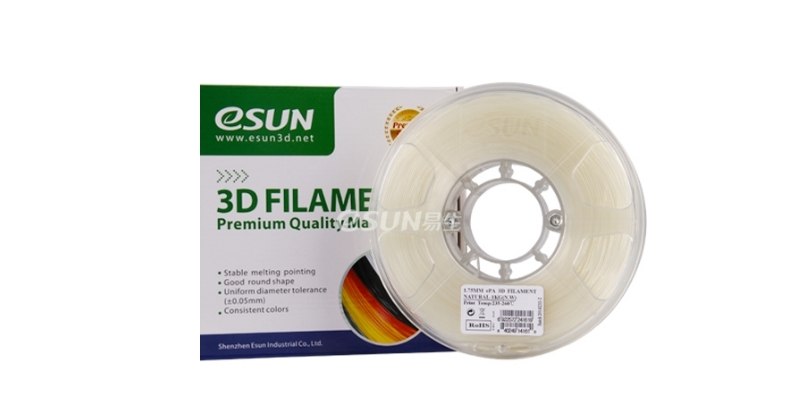
eSUN ePA Nylon is a solid choice if you’re looking for something a little more reliable than the ultra-budget options. It boasts excellent all-round resistance to heat, chemicals, impact, and wear with a classic tough, durable, and reasonably flexible Nylon profile. It’s somewhat prone to warping, but nothing a good dollop of glue or Magigoo and a PEI surface won’t help mitigate.
Because eSUN EPA Nylon ships transparent, it’s particularly well suited to dyeing and absorbs color well. So, though there are no colors to choose from, you can quickly adapt the filament to your project’s needs. eSUN also claims the filament is non-toxic.
Polymaker PolyMide CoPA
- Price: Check price on Amazon here
- Printing Temperature: 250-270°C
- Bed Temperature: 25-50°C
- Filament Diameter: 1.75 mm, 2.85 mm
- Available Colors: Black
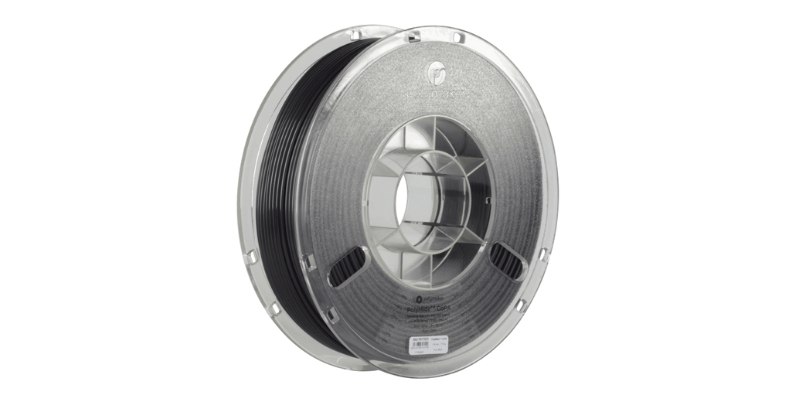
Polymaker PolyMide CoPA is a high-quality, premium filament designed to merge easy printing with properties fit for the most demanding applications. It’s strong, tough, and heat resistant up to 180°C.
Among commercially available Nylon, Polymaker PolyMide CoPA is one of the least susceptible to first-layer woes courtesy of Polymaker’s Warp-Free technology, which is not just marketing spin but a genuine feature.
Polymaker PolyMide CoPA ships in a resealable vacuum bag, so you won’t need to source a purpose container to keep it dry between print sessions. Color is limited to black, and the asking price is comparatively high, but the quality of the printed filament justifies the higher price tag.
Polymaker PolyMide PA6-CF
- Price: Check price on Amazon here
- Printing Temperature: 280-300°C
- Bed Temperature: 25-50°C
- Filament Diameter: 1.75 mm, 2.85 mm
- Available Colors: Black

Polymaker PolyMide PA6-CF combines PolyMaker’s standard PA filament Nylon with carbon fiber. The carbon reinforcing ensures the material is stiff, durable, and heat resistant while also making it less challenging to print with superb layer adhesion.
As with Polymaker’s other PolyMide filament, PA6-CF features Warp-Free technology. It deflects heat up to 215°C. It excels for the most demanding engineering applications; just make sure you have a hardened, wear-resistant nozzle for the best results.
Polymaker PolyMide PA6-GF
- Price: Check price on Amazon here
- Printing Temperature: 280-300°C
- Bed Temperature: 25-50°C
- Filament Diameter: 1.75 mm, 2.85 mm
- Available Colors: Gray
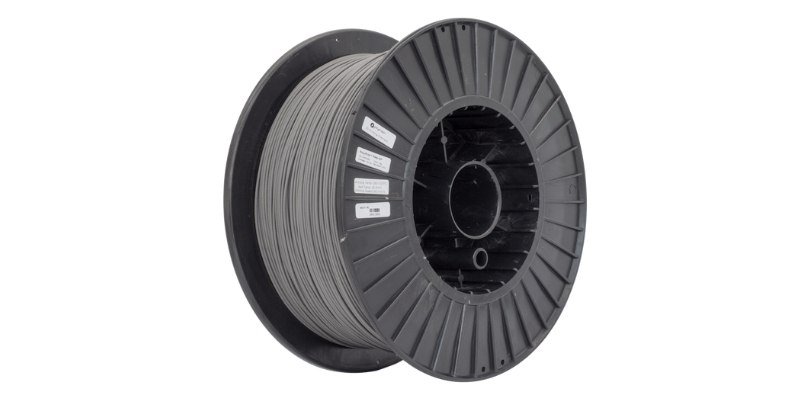
Last but not least in Polymaker’s Nylon range, we have Polymaker PolyMide PA6-GF. This time, the Nylon is reinforced with glass fiber for superb impact resistance and the usual thermal and mechanical properties you’d expect from Nylon.
It’s designed to keep warping to a minimum, thanks to Polymaker’s Warp-Free technology. While a high-quality product, PolyMide PA6-GF is among the cheapest Polymaker Nylon-filled materials.
colorFabb PA Neat
- Price: $60.00 – 0.5 kg spool – Available here
- Printing Temperature: 265-290°C
- Bed Temperature: 50°C
- Filament Diameter: 1.75 mm, 2.85 mm
- Available Colors: Black
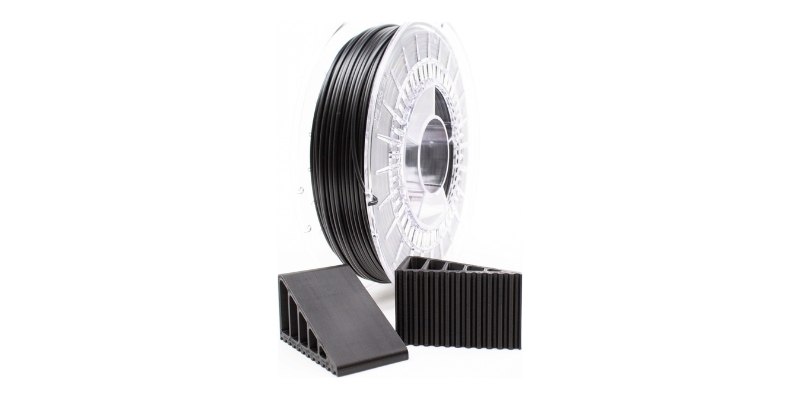
colorFabb PA Neat is a straight Nylon FDM filament with low-warp properties designed to retain its mechanical and temperature resistant properties up to 120°C. It’s a premium filament that’s tough and produces consistently impressive prints.
Taulmann Glass Fiber Alloy Nylon
- Price: Check price on Amazon here
- Printing Temperature: 250-260°C
- Bed Temperature: 55°C
- Filament Diameter: 1.75 mm, 2.85 mm
- Available Colors: Beige
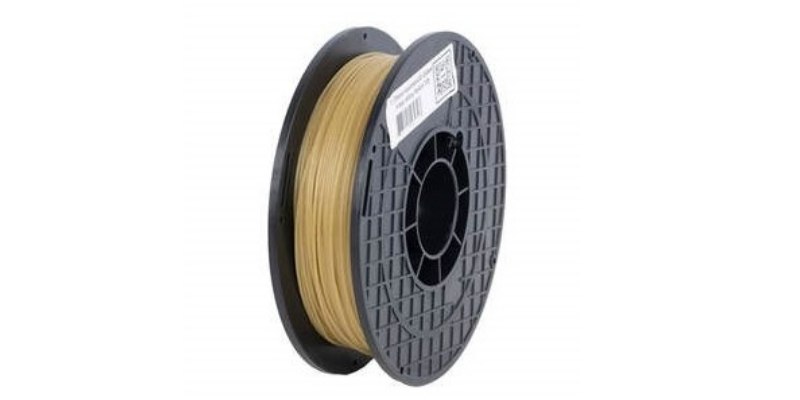
Taulmann Glass Fiber Alloy Nylon is another glass fiber reinforced Nylon we have no qualms recommending. It’s affordable and represents the culmination of a year’s worth of research on Taulmann’s part to nail the perfect formula.
It features a custom Nylon-glass fiber blend designed to meet the tensile and thermal resistant needs of demanding industries like aerospace, automotive, and defense.
Ultimaker Nylon
- Price: $70.00-$80.00 – 0.75 kg spool – Available at Matterhackers here
- Printing Temperature: 230-260°C
- Bed Temperature: 60-70°C
- Filament Diameter: 2.85 mm
- Available Colors: Black, Transparent
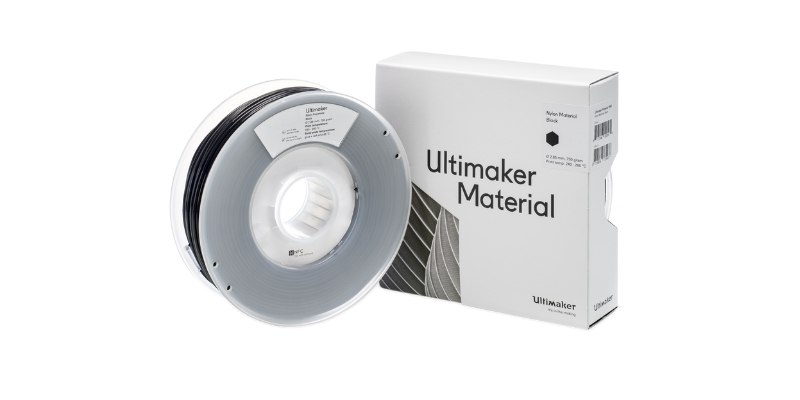
A professional option targeting manufacturing and engineering applications, Ultimaker Nylon is one of the best Nylon 3D printer filament options if you have the cash to spare. Ultimaker Nylon is engineered to resist ambient humidity far better than most Nylon brands, meaning reduced moisture absorption, largely removing the need to dry filament if stored correctly.
It features a balanced profile, juggling solid durability, corrosion resistance, and ductility up to 210% of its original form before breaking. Note it’s only available in 2.85 mm filament diameter.
Fiberthree F3 PA Pure Pro
- Price: $83.00 – 0.5 kg spool – Available at Prusa store here
- Printing Temperature: 275-285°C
- Bed Temperature: 60-70°C
- Filament Diameter: 1.75 mm
- Available Colors: White, Black

Fiberthree F3 PA Pure Pro is an unfilled PA 6 Nylon with high tensile strength, low moisture absorption properties, and a solid resistance profile covering heat, chemicals, and abrasion.
Printed parts come out with a smooth surface finish. Fiberthree F3 PA Pure Pro’s low warp properties and solid adhesion performance make printing a tad easier than a big chunk of the other Nylon filament brands on the market.
At $83.00 for a kilo spool, Fiberthree F3 PA Pure Pro hits the wallet quite hard, so we don’t recommend the investment unless you need a high-quality Nylon filament.
Best Nylon Filament Brands
Matterhackers Pro Series Nylon offers outstanding quality filament at a reasonable price. Additionally, Matterhackers proposes a broad range of colors to choose from in the Pros Series Nylon range, along with two 1.75 mm and 2.85 mm options. Matterhackers Pro Series Nylon comes highly rated for commercial prototyping.
Overture Nylon is another excellent choice for those sticking to a budget and willing to sacrifice quality for a lower price. We see it as a perfect choice for beginners trying their hand at Nylon for the first time. We particularly like the anti-warping and odorless features. It’s available in 1.75 mm, either in gray or black.
Also worth mentioning for businesses and designers not willing to compromise on quality is Ultimaker Nylon. Premium through and through, it delivers quality prints with also a nod to nylon’s tricky storage with work done to minimize moisture absorption. You’ll find Ultimaker Nylon available in 2.85 mm diameter, in either black or transparent.
How much does Nylon filament cost?
Prices vary based on the type and blend, but generally the cheapest nylon filaments cost around $30 per kilo. High-quality nylon filament can cost between $60 and $80, and other blends such as carbon fiber or glass-infused blends can cost significantly more.
Reasons to 3D Print Nylon
3D Printed Nylon is Extremely Durable
You typically won’t find it snapping like brittle materials. When printed in thick parts, with higher density infill and wider wall thicknesses it produces a very strong part that can handle significant shock and has excellent impact resistance.
However when printed thinly it becomes very flexible – think living hinges and other high use parts.

Nylon 3D filament Has a Very Low Friction Coefficient
This means Nylon is ideal for moving parts. If you need a bushing for a lower RPM shaft where a bearing would be too small or unnecessary, Nylon would be the perfect material. Or those white gears in RC car gearboxes? They’re Nylon, and they don’t need lubrication because of the low friction coefficient.
It Has Incredible Tensile Strength
Have you ever tried to break a cable tie, using your hands? It likely didn’t work out too well. They’re usually made from Nylon – for good reason. Nylon rope is also very common, having exceptional tensile strength.

It’s Very Flexible
As a result, Nylon parts are not only strong, but have great impact resistance. This makes Nylon filament ideal for parts that will come under a lot of strain and force, such as in mechanical gears and functional parts.
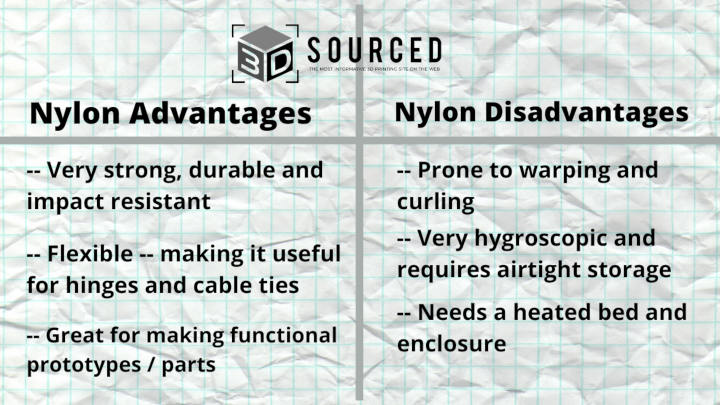
Disadvantages of Nylon filament
- Prone to warping: if not properly optimized, 3D printed Nylon parts can curl up on the edges, rendering functional parts such as gears completely useless. Carefully optimized print settings are required, as well as a heated bed, enclosure, and build surface to prevent warping.
- Requires airtight storage: to stop water absorption which affects print quality. This adds to expense, though we recommend filament containers further on in this article that can extrude directly from a small hole, so you do not need to remove filament to print.
- Requires additional investment in a high-quality hot end: we highly recommend upgrading to a high-quality hot end, which we recommend in our hot end buyer’s guide. Nylon is tough and requires higher temperatures than filaments like PLA, which some more basic hot ends can struggle with. To get the most out of your filament, consider upgrading your hot end.
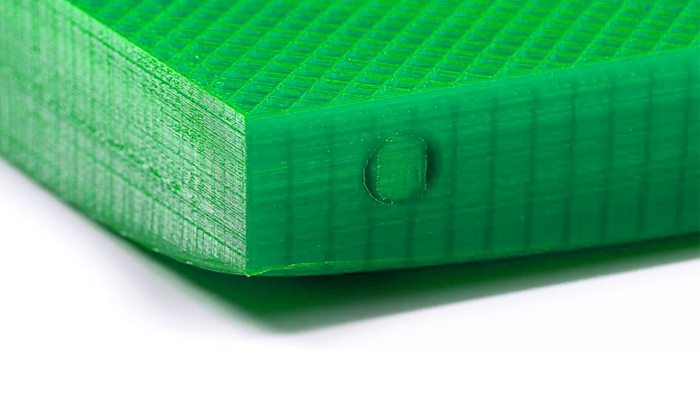
Tips to get the best results from Nylon 3D printing
Use a 3D printer with an enclosure
Some Nylons are prone to warping as a result of the huge change between the printing temperature and the outside environment. A heated bed can help, especially with the bottom layers, but a heated chamber or enclosure works far better at controlling warping and curling.
Optimize printing settings
If necessary, consider using brims or rafts to prevent warping, and use the correct heated bed and extruder temperatures for the best results.
We highlight the most important 3D slicer settings here.

Dry filament before use oruse an airtight filament container
Dry filament prints better quality, stronger, and more crisp surface finish parts.
In the image below, you can see two Moai, printed exactly the same with the same settings. The one on the right has just been left out for a week, to absorb some moisture from the air. From the photo the difference is subtle, but look closely and you’ll see some differences.

Nylon filament that’s absorbed water before printing will lead to poor print finishes, or even popping in the extruder. You can see the surface of the water exposed (right) Moai is frosty, with wispy stringing on the surface.
The dry Nylon filament on the left has a nice smooth sheen, and you can faintly see the large pattern infill inside, showing it’s slightly transparent. There’s also a lot more detail on the dry Nylon 12 figure.
In worst case scenarios you’ll hear popping while printing, which will also give the print a very rough surface. Nylon delamination can also be caused by moisture, but is usually a symptom of not being printed hot enough.
Rule of thumb with Nylon? Always dry it before use.
Use a 3D Printer With An All-Metal Extruder
As a durable, abrasive material, nylon takes a toll on a 3D printer, which is why an all-metal extruder capable of reaching temperatures, ideally up to 300°C, is vital for successful nylon printing.
Use a Heated Bed
Nylon’s temperature sensitivity means you’ll need to provide the requisite heat, chiefly from the extruder.
But, also by using a heated bed reaching temperatures around 100-degrees centigrade for the best results. Doing so guarantees better adhesion and reduces the likelihood of unwanted warping.
Nylon Applications
Nylon is commonly used to create durable and long-lasting plastic gears, screws, hinges, nuts and bolts and cable ties. Beyond this, custom parts that need to be strong, as well as somewhat flexible, are often best for Nylon.
Nylon is commonly used to make gears due to its low friction and good abrasion resistance, with its flexibility also making it useful to create hinges. Within 3D printing, Nylon is used in durable parts for rapid prototyping, as well as often in homemade maker projects such as on drones or RC cars.

How to Store Nylon
Nylon is extremely hygroscopic, absorbing huge amounts of water from the air, which can ruin printing quality and result in weaker, bubbly parts. To prevent this, Nylon filament should be kept in a filament container.
We recommend the following products below to keep your filament in the best condition.
Providing you’ve stored your Nylon spool in an air tight bag with desiccant you shouldn’t need to dry your Nylon before printing. However as it is very susceptible to absorbing moisture in a short time frame – if you’re getting an uneven finish quality or even popping during printing, then you’ll need to dry it out.
Popping is caused when the moisture in the filament heats into steam quickly and expands out of the extruder. It ruins prints.
How to Dry Nylon
Nylon Filament Dryers
Filament dryers remove a significant amount of the moisture that your filament absorbs, resulting in better quality prints with better surface finish. A dryer, coupled with the appropriate storage container, can keep Nylon in great printing shape for a long time.
We recommend the following:
Oven
Or, you can simply place your spool in the oven at around 85°C (or about 180°F) for a good 5-6 hours. Never leave it unattended, of course. You can also ‘recharge’ your silica gel desiccants this way too.
Different Types of Nylon Filament
NylonX
NylonX is a hybrid Nylon filament with carbon fibers added to further improve toughness and improve stiffness.
Though used sometimes by committed makers, NylonX is mostly used for industrial uses such as in rapid prototyping, and it is recommended to use hardened metal nozzle as these filaments can wear down nozzles quickly.
Read more: NylonX 3D printer filament guide
NylonG
Similar to NylonX but instead of carbon fibers, NylonG is Nylon blended with glass fibers to improve strength and resistance further.
Again, this is a mainly industrial filament, though some hobbyists will find niche everyday uses.
Do You Need an Enclosed Chamber to 3D Print Nylon Filament?
Printing Nylon filament within an enclosure is recommended. Like ABS, the idea is to minimize the potential for warping and curling, which is generally caused by printed Nylon cooling too quickly due to temperature variations in the work area.
An enclosure ensures a more or less fixed ambient temperature around the printer, allowing the Nylon to cool steadily and uniformly. A further benefit of an enclosure (ideally one with a filter and venting system) is protection from the fumes emitted when Nylon melts.
What Temperature Should I Print Nylon Filament At?
Nylon requires a nozzle temperature of anywhere from 230°C to 290°C. The exact temperature you’ll need to set depends on the brand of Nylon filament you’re using, so be sure to check the manufacturer’s recommended settings for an exact number.
Can Water in Nylon Filament Cause Extruder Clogs?
Yes, Nylon that’s absorbed large amounts of moisture can cause clogging. As Nylon heats up, the water trapped inside effectively boils and evaporates (a queue for this is cracking, popping, and hissing from the nozzle), creating gaps in the Nylon that can lead to clogs.
Is Nylon Filament Toxic?
According to a study published in 2016, melted Nylon produced by certain brands can release small amounts of a volatile organic compound called caprolactam, which can cause short-term irritation to the eyes, nose, and throat, along with headaches and confusion when inhaled.
The lack of more recent and in-depth studies means the true toxicity of Nylon printing isn’t currently established. To err on the side of caution, we recommend taking practical steps to minimize exposure to potentially toxic Nylon fumes, such as working in a well-ventilated area, using an enclosure with an air filter, and sticking to reputable Nylon brands.
What the difference between Nylon 6 filament and Nylon 12?
Without getting too technical, the most common grades are Nylon 6 and Nylon 6/6 (sometimes referred to as Nylon 66). A more commonly heard make is Taulman Nylon, they also produce 618 and 645 and other versions of 6.
These two grades (6 and 6/6), while offering excellent strength and hardness aren’t as thermo or chemically stable as the newer Nylon 6 vs Nylon 12. Grade 12 will hold its shape more consistently over a wider range of temperatures, but also isn’t as sensitive to water absorption as the 6’s.
All Nylon is hygroscopic, meaning it will absorb water. In fact, Nylon typically can absorb 10% of its density of water in just 24 hours! So make sure you keep it locked in an air tight bag or container with desiccant. Grade 12 absorbs water at half the rate of 6 and 6/6, so all things considered you could argue it’s more suited to 3D printing.
Whereas after printing, if your Nylon 3D filament absorbs moisture it can change the various properties of the material considerably – so Nylon 12 with its lower water absorption is favorable.
Like a lot of printing plastics, there are different grades available – it’s important to get a grade that matches (or exceeds) the task that you need it for.
- How strong is 3D printed plastic? Read here to find out.
Nylon 3D Printing FAQs
Is Nylon Stronger Than PLA?
Nylon displays less overall strength than PLA, but makes up for this with vastly better durability, notably high abrasion tolerance, meaning it can handle substantial wear and tear. Additionally, the material has a high chemical resistance, unlike PLA, which has a low melting point and is particularly brittle.
Which Is Stronger, Nylon or PETG?
Nylon trumps PETG ever so slightly for overall strength, thanks to its durability and flexibility. On the other hand, PETG takes the upper hand for water resistance, something nylon struggles with due to its high water absorption properties.
3D Printing Nylon vs ABS: Which Is Stronger?
Nylon is far the strongest material type of the two. ABS is a little over half as strong as nylon by tensile strength measurements (4,700 psi to nylon’s estimated 7,000).
Strength isn’t the be-all and end-all of a filament’s viability, though. ABS shines for applications where high chemical and heat resistance along with stiffness are essential, such as electrical insulation, protective equipment, toys, and more.
Nylon fares better for applications such as household items subject to substantial daily wear and tear or functional parts where durability and flexibility are of prime importance.
How Strong Is 3D Printed Nylon?
3D printed nylon boasts an estimated tensile strength of around 7,000 psi. In real terms, this equates to enough strength and durability to confidently support up to 200 kg before yielding and breaking.
Is Nylon Filament Flexible?
Relative to standard 3D printer filaments like PLA and ABS, Nylon is relatively flexible but doesn’t have elastic properties approaching those of filaments like TPU. Nylon’s flexibility tends to tumble as thickness increases.
Can Nylon Filament Be Painted?
3D printing with Nylon filament is notoriously difficult to paint due to its surface composition. You can mitigate some of this with rather involved heat treatment or priming work, but the overall consensus among makers is that Nylon is better suited to dyeing. You can dye the filament either before or after printing. MatterHackers has an excellent guide on how to go about dyeing Nylon.
Can You Dye Nylon Filament?
Nylon’s water absorption rate is good for something – you can actually dye Nylon with interesting results. Just be extra sure to thoroughly dry out the filament after dying. It may be better to dye 3D printed Nylon post-print, so as not to affect the printing process.
If you are interested in our other filament guides, check out:
- The best Nylon 3D printers
- The best TPU filaments (and TPE, flexibles)
- Our complete guide to ABS filament
- Our complete guide to PLA filament
- Our comparison of PLA vs ABS
- The best 3D printers buyer’s guide
- The top 10 FDM 3D printers
- Gluing 3D prints – best glue for nylon (and PLA, ABS, PETG)
- What’s the best filament to use with Ender 3?

